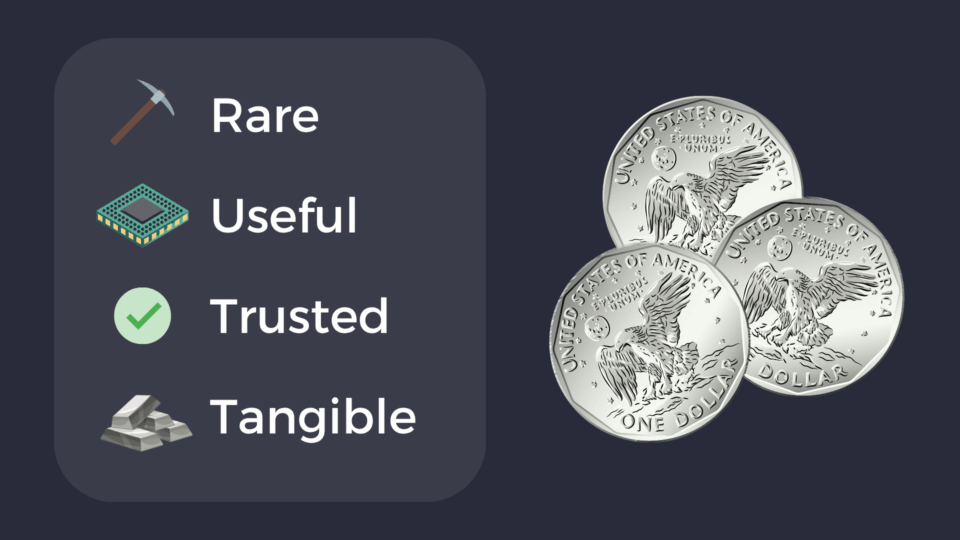Silver is one of the most attractive investment opportunities today. Despite its growing applications in technology, silver remains extremely undervalued.
It is rare, but not too rare.
Silver makes up about 0.07 parts per million of the Earth’s crust, scarce enough to remain valuable but common enough to be used in coinage and trade for thousands of years.
Gold is too rare and valuable for small transactions, but silver’s relative abundance makes it practical for everyday commerce.
Silver is often a byproduct of mining other metals (copper, lead, zinc), so its production does not easily scale with price increases, supporting long-term supply constraints.
It has important industrial uses.
Silver is more than just a store of value.
It is a critical material in everything from semiconductors to solar panels to medical devices. Its utility comes from three key properties:
- Conductivity: Silver conducts electricity more efficiently than any other metal (even copper), which means electricity flows through it with very little resistance. Silver is used in switches, RFID chips, circuit boards, and contacts in smartphones and computers.
- Reflectivity: Silver reflects light and heat more efficiently than any other metal. It is used in solar panels to maximize energy absorption. Silver coatings are critical in mirrors, reflective lenses, and specialized optical instruments.
- Antimicrobial properties: Silver naturally inhibits bacterial growth. It is increasingly required in medical technologies such as surgical tools, wound dressings, medical implants, and water purification systems.
As industries such as renewable energy, electric vehicles, advanced electronics, and artificial intelligence grow, demand for silver will continue to rise.
Humans have relied on it for thousands of years.
Just a few examples:
- Ancient Egyptians used finely powdered silver in their black eye makeup, believing it had protective and healing properties against infections and the “evil eye.”
- Alexander the Great’s army used silver containers to store water and keep it fresh during long campaigns (unknowingly taking advantage of silver’s antibacterial properties).
- In the Middle Ages, wealthy families gave babies a silver spoon to suck on to ward off illness, hence the phrase “born with a silver spoon in your mouth.”
- During the Black Death, people would place small silver coins in water containers to purify water and protect themselves from plague.
- American cowboys would drop a silver dollar into their whiskey to test for poison or impurities before taking a drink in shady saloons.
It is a hedge against currency devaluation.
When governments print money, fiat currencies lose purchasing power. Silver will always retain its value because we cannot create more of it.
In periods of high inflation or currency crises (1970s U.S. inflation, Argentina, Venezuela), silver prices often rise as people seek tangible assets. Lower interest rates and money printing increase silver’s investment demand.
It has been money for thousands of years.
Nearly every great civilization built its monetary system on silver, including Ancient Mesopotamia, Egypt, Greece, and Rome, the Chinese Dynasties, the Byzantine, Ottoman, Spanish, and British Empires, and even the United States.
The U.S. dollar was originally defined as 371.25 grains of pure silver under the Coinage Act of 1792.
Silver is durable, easily divisible, portable, and widely recognizable, making it a stable store of value and medium of exchange.
Today, silver has global markets with standardized pricing. You can hold it, store it, and count on it to retain value across time.
It carries no counterparty risk.
Silver offers something rare in the world of finance: intrinsic value.
Stocks rely on a company’s performance. Bonds depend on someone else repaying their debts. Fiat currencies rely on the governments that print them.
Silver does not require someone else to make the right decisions, pay interest, or manage a balance sheet. Its value comes from its intrinsic qualities. It cannot go bankrupt.
Physical silver transactions can be conducted privately, providing a level of financial independence. Many see silver as part of a “financial insurance policy” to protect wealth if traditional systems fail.
Precious metals do not require a central bank, a government, or even a functioning economy to operate as money.
This is the core value proposition of owning silver: it exists independent of political systems, business cycles, and debt markets. It is real money.
Why Invest in Silver?
Silver’s value comes from a unique combination of scarcity, essential industrial uses, millennia of monetary trust, and protection against inflation.
It is more important today than ever, yet it is currently undervalued against other asset classes.
Silver is Historically Undervalued
Silver prices remain far below previous peaks in 1980 and 2011.
Silver’s price needs to double or triple just to match its historical averages compared to stocks and gold. Just take a look at the historical charts:
Silver / Stocks Chart
This chart divides the price of silver by the price of the S&P 500 over the last 100 years.
A low value means that silver is historically undervalued against the stock market.
Silver / Gold Chart
This chart divides the silver price by the gold price over the last 100 years. (This shows the inverse of the gold/silver ratio commonly used in precious metals trading.)
A low value means that silver is historically undervalued against gold.
Right now, every precious metals portfolio should have a strategic silver position.
Silver Outperforms Gold During Bull Markets
There have been two great precious metals bull markets in recent history:
1968 – 1980
- Gold: 2,435% return ($34.51/oz to $875.00/oz)
- Silver: 3,621% return ($1.29/oz to $48.00/oz)
2001 – 2011
- Gold: 656% return ($254.10/oz to $1,920.94/oz)
- Silver: 1,130% return ($4.05/oz to $49.83/oz)
When precious metals enter a bull market, silver offers higher returns to investors who position themselves early. Its volatility allows for greater profit potential.
Why Choose Vaulted Silver?
Vaulted Silver offers simplicity, security, and outstanding value. Here’s why:
- Real, physical silver: You own 99.9% pure silver bars stored in professional vaults, not a paper promise or ETF. Each bar is individually tracked by serial number in your Vaulted account.
- Easy and Secure: The Vaulted app is user-friendly, secure, and provides real-time transparency.
- Lowest Costs: Vaulted offers the lowest fees in the industry due to a simplified supply chain.
In uncertain economic times, holding physical silver provides unmatched security and growth potential. Silver ownership puts you in control.
With historically low prices and rising industrial demand, silver is positioned to deliver excellent returns and safeguard your wealth.











